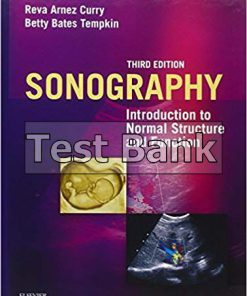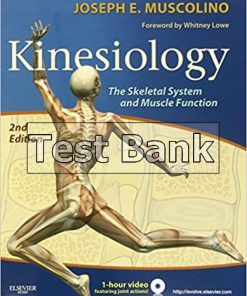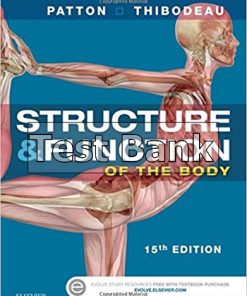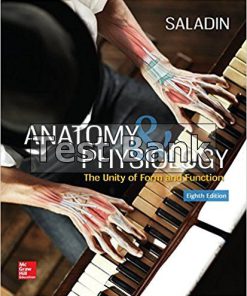Joint Structure and Function 5th Edition Levangie Test Bank
$50.00 Original price was: $50.00.$26.50Current price is: $26.50.
Joint Structure and Function 5th Edition Levangie Test Bank.
Joint Structure and Function 5th Edition Levangie Test Bank
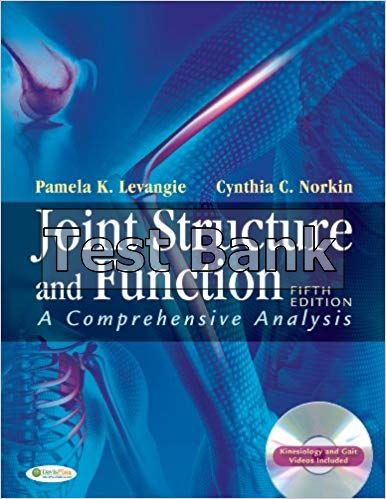
Product details:
- ISBN-10 : 0803623623
- ISBN-13 : 978-0803623620
- Author:
The perfect balance of clarity and comprehensiveness―now more reader friendly and visually appealing than ever. This popular text offers the clear, logical discussions of the basic theory of joint structure and muscle action and provides the foundation you need to understand both normal and pathologic function. The 5th Edition features a dynamic new full color design, videos, and a streamlined biomechanics chapter. Thoroughly revised and updated, it incorporates the latest research findings and techniques, reflecting the text’s emphasis on evidence-based practice.
Table contents:
- Section 1 Joint Structure and Function: Foundational Concepts
- Chapter 1 Biomechanical Applications to Joint Structure and Function
- INTRODUCTION
- case 1-1 Patient Case
- Figure 1–1 A. Leg-press exercise apparatus for strengthening hip and knee extensor muscles. B. Free weight boot for strengthening knee extensor muscles.
- Figure 1–2 A. Schematic representation of the leg-foot segment in the leg-press exercise, with the leg-foot segment highlighted for emphasis. B. Schematic representation of the leg-foot segment in the weight boot exercise, with the leg-foot segment highlighted for emphasis.
- Part 1: Kinematics and Introduction to Kinetics
- DESCRIPTIONS OF MOTION
- Types of Displacement
- Translatory Motion
- Figure 1–3 An example of translatory motion is the anterior drawer test for ACL integrity. Ideally, the tibial plateau translates anteriorly from the starting position (A) to the ending position (B) as the examiner exerts a linear load on the proximal tibia. Under ideal conditions, each point on the tibia moves through the same distance, at the same time, in parallel paths.
- Rotary Motion
- Figure 1–4 Rotary motion. Each point in the tibia segment moves through the same angle, at the same time, at a constant distance from the center of rotation or axis (A).
- General Motion
- Location of Displacement in Space
- Figure 1–5 Body in anatomic position showing the x-axis, y-axis, and z-axis of the Cartesian coordinate system (the coronal, vertical, and anteroposterior axes, respectively).
- Figure 1–6 The sagittal plane.
- Figure 1–7 The transverse plane.
- Figure 1–8 The frontal plane.
- Example 1-1
- Figure 1–9 The forearm-hand segment rotates around a coronal axis at the elbow joint and along A-P axis (through rotation at the shoulder joint), using two degrees of freedom that result in a moving axis of rotation and produce curvilinear motion of the forearm-hand segment.
- Direction of Displacement
- Magnitude of Displacement
- Figure 1–10 An angle of 57.3° describes an arc of 1 radian.
- Rate of Displacement
- Figure 1–11 When a joint’s range of motion is plotted on the y-axis (vertical axis) and time is plotted on the x-axis (horizontal axis), the resulting time-series plot portrays the change in joint position over time. The slope of the plotted line reflects the velocity of the joint change.
- Figure 1–12 Movement of a point on a segment can be displayed by plotting the acceleration of the segment (y-axis) over time (x-axis). The slope and trend of the line represent increases or decreases in magnitude of acceleration as the movement continues.
- INTRODUCTION TO FORCES
- Definition of Forces
- Continuing Exploration 1-1: A Force
- Continuing Exploration 1-2: Force and Mass Unit Terminology
- Concept Cornerstone 1-1 Primary Rules of Forces
- Force Vectors
- Figure 1–13 Vector representation of the pull of the weight boot on the leg-foot segment (weightboot-on-legfoot [WbLf]), with a magnitude proportional to the mass and equivalent to the weight of the apparatus.
- Figure 1–14 Vector MFh represents the pull of a muscle on the forearm-hand segment.
- Continuing Exploration 1-3: Pounds and Newtons
- Figure 1–15 A. Vector representation of the force of the footplate of the leg-press machine on the leg-foot segment (footplate-on-legfoot [FpLf]). B. The vector footplate-on-legfoot (FpLf) may be drawn with any length and with a point of application anywhere along the line of pull of the vector as long as the point of application remains on the leg-foot segment. C. The push of the footplate on the leg-foot segment is commonly shown elsewhere by placing the arrowhead of vector FpLf at the point of application.
- Figure 1–16 The vector representing the pull of a strap connected to each side of the leg-foot segment (strap-on-legfoot [SLf]) will look the same as the push of the footplate on the leg-foot segment (Fig. 1–15A) because both have identical effects on the leg-foot segment as long as the direction and magnitude are the same.
- Concept Cornerstone 1-2 Force Vectors Are Characterized By:
- Concept Cornerstone 1-3 Naming Forces
- Figure 1–17 An unknown vector (X) can be named by identifying the segment to which it is applied and the source of the force (something that must be touching the segment).
- Force of Gravity
- Figure 1–18 A. Center of mass of a symmetrical object. B. Center of mass of an asymmetrical object. C. The center of mass may lie outside the object.
- Segmental Centers of Mass and Composition of Gravitational Forces
- Figure 1–19 A. Gravity acting on the arm segment (GA), the forearm segment (GF), and the hand segment (GH). B. Gravity acting on the arm (GA) and forearm-hand segments (GFh). C. Gravity acting on the arm-forearm-hand segment (GAFh). D. The CoM of the arm-forearm-hand segment shifts when segments are rearranged.
- Example 1-2
- Center of Mass of the Human Body
- Example 1-3
- Figure 1–20 The CoM of the human body lies approximately at S2, anterior to the sacrum (inset). The extended LoG lies within the BoS.
- Figure 1–21 Rearrangement of the head, arms, and trunk (HAT) in relation to the lower extremities produces a new combined CoM and a new location for the LoG in relation to the base of support.
- Figure 1–22 CoM of the football player’s left leg (A) and the right leg (B) combine to form the CoM for the lower limbs (AB). The CoM (AB) combines with the upper trunk CoM (C) to produce the CoM for the entire body (ABC). The LoG from the combined CoM falls well outside the football player’s BoS. He is unstable and cannot maintain this position.
- Center of Mass, Line of Gravity, and Stability
- Figure 1–23 A wide base of support permits a wide excursion of the LoG without the LoG falling outside the base of support.
- Alterations in Mass of an Object or Segment
- Example 1-4
- Figure 1–24 The addition of the weight of the cast has shifted the CoM. The addition of crutches enlarges the base of support to the shaded area between the weight-bearing foot and crutches to improve stability.
- Concept Cornerstone 1-4 Stability of an Object or the Human Body
- INTRODUCTION TO STATICS AND DYNAMICS
- Newton’s Law of Inertia
- Newton’s Law of Acceleration
- Concept Cornerstone 1-5 Applying the Law of Acceleration (Inertia)
- TRANSLATORY MOTION IN LINEAR AND CONCURRENT FORCE SYSTEMS
- Figure 1–25 The forces of gravity-on-legfoot (GLf) and weightboot-on-legfoot (WbLf) are in the same linear force system when the leg-foot segment is at 90° of knee flexion.
- Linear Force Systems
- Determining Resultant Forces in a Linear Force System
- Figure 1–26 A. Schematic representation of the pull of the anterior capsule (AcLf) and posterior capsule (PcLf) on the leg-foot segment. B. Determination of the direction and relative magnitude of the resultant (capsule-on-legfoot [CLf]) of concurrent forces AcLf and PcLf, through the process of composition by parallelogram. C. The resultant force CLf has been added to the leg-foot segment, with a magnitude equivalent to that of GLf + WbLf.
- Concurrent Force Systems
- Determining Resultant Forces in a Concurrent Force System
- Example 1-5
- Continuing Exploration 1-4: Trigonometric Solution
- Figure 1–27 The cosine law for triangles is used to compute the magnitude of CLf, given the magnitudes of AcLf and PcLf, as well as the angle of application (α) between them. The relevant angle (β) is the complement of angle α (180° − α).
- Newton’s Law of Reaction
- Continuing Exploration 1-5: Reactions to Leg-Foot Segment Forces
- Figure 1–28 Weightboot-on-legfoot (WbLf) and legfoot-on-weightboot (LfWb) are reaction forces or an interaction pair. Both forces exist by virtue of the contact between the two objects. Although separated for clarity, these two vectors will be in line with each other.
- Gravitational and Contact Forces
- Figure 1–29 Although a scale is commonly thought to measure the weight of the person (gravity-on-person [GP]), it actually measures the contact of the person-on-scale (PS). Vectors GP and PS are equal in magnitude as long as nothing else is touching the person.
- Concept Cornerstone 1-6 Action-Reaction Forces
- ADDITIONAL LINEAR FORCE CONSIDERATIONS
- Tensile Forces
- Figure 1–30 The tensile forces of the pull of hand-on-rope (HR) and the pull of the cement block on the rope (BR) produce two forces of equal magnitude (110 N) that result in 110 N of tension within and throughout the rope.
- Tensile Forces and Their Reaction Forces
- Figure 1–31 Equilibrium of the man will be achieved when the force of the rope-on-hand (RH) reaches the magnitude of muscles-on-hand (MsH). Rope-on-hand will not reach the 110 N magnitude needed to establish equilibrium until the tension in the initially slack rope reaches that magnitude as the man accelerates away from the block.
- Figure 1–32 If the rope cannot withstand the tensile forces placed on it, it will break. Once the rope breaks, the force of muscles-on-hand (MsH) is unopposed, and the man will accelerate backward.
- CASE APPLICATION case 1–1 Tension in the Knee Joint Capsule
- Concept Cornerstone 1-7 Tension and Tensile Forces
- Figure 1–33 The pull of the capsule-on-legfoot (CLf) must have a concomitant reaction force of legfoot-on-capsule (LfC) that is an 88-N tensile force on the joint capsule.
- Joint Distraction
- Figure 1–34 The tensile forces of legfoot-on-capsule (LfC) and femur-on-capsule (FC) are shown acting on the capsule.
- Figure 1–35 The forces of table-on-legfoot (TLf) and gravity-on-legfoot (GLf) in this position are sufficient for equilibrium of the leg-foot segment, with zero (or negligible) tension in the knee joint capsule.
- Figure 1–36 As long as the 88-N force on the leg-foot segment from gravity (GLf) and the weight boot (WbLf) are supported by an equal upward force from the hand (HLf), the tension in the capsule and ligaments will be zero (or negligible).
- Continuing Exploration 1-6: Acceleration in Joint Distraction
- Distraction Forces
- Continuing Exploration 1-7: Stabilization of the Femur
- Figure 1–37 Distraction of the joint and tensile forces in the knee joint capsule occurs when there is a net distractive force directed away from the joint surfaces applied to each of the adjacent joint segments (dashed vectors). The distractive force on the femur is provided by the force of table-on-femur (TF), whereas the distractive force on the leg-foot segment is provided by GWbLf.
- Concept Cornerstone 1-8 Joint Distraction and Distraction Forces
- Joint Compression and Joint Reaction Forces
- Figure 1–38 Joint compression results in joint reaction forces (FLf and LfF) when there is a net compression force applied to each of the adjacent joint segments (dashed vectors) toward the joint surfaces, in this case provided by hand-on-legfoot (HLf) and gravity-on-femur (GF).
- Continuing Exploration 1-8: Close-Packing of a Joint
- Revisiting Newton’s Law of Inertia
- Concept Cornerstone 1-9 Joint Compression and Joint Compression Forces
People also search:
joint structure and function by cynthia norkin pdf 5th edition
seven joint functions
structure and function of joint capsule
5-2 study guide and intervention composition of functions
c function name rules
Instant download after Payment is complete
You may also like…
Related products
Test Bank





